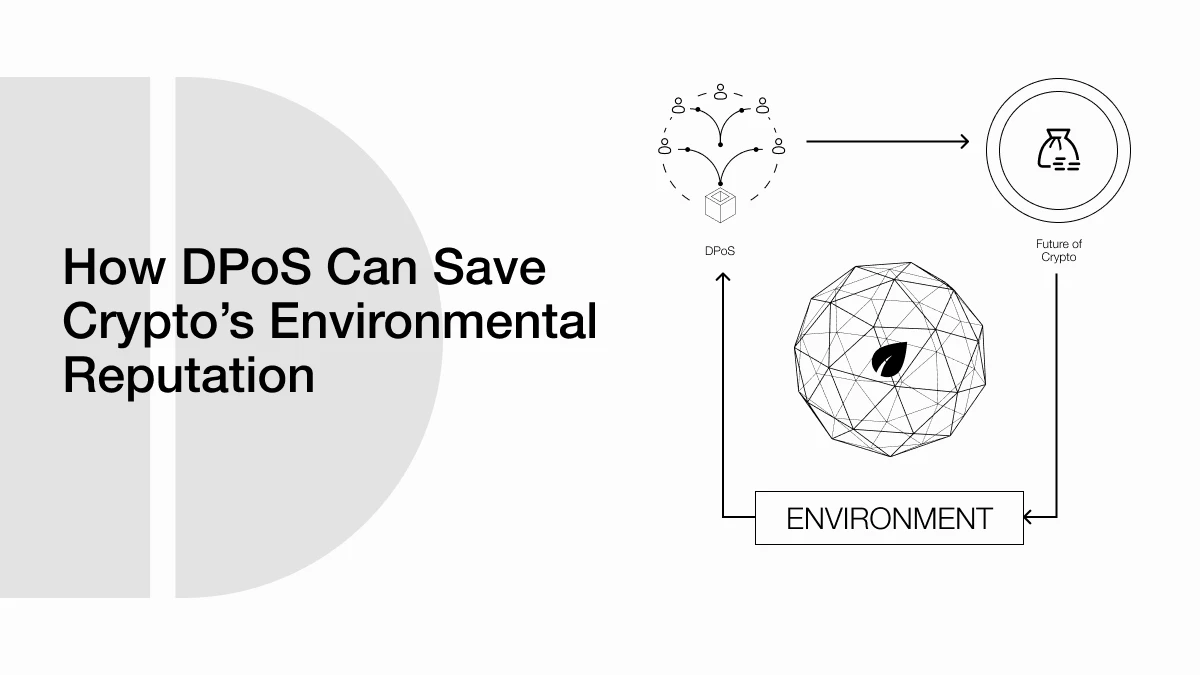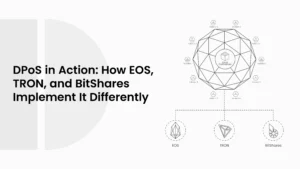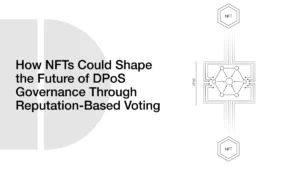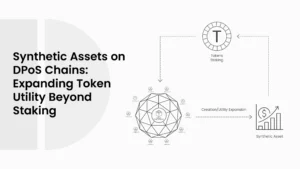How DPoS Can Save Crypto’s Environmental Reputation

Blockchain has revolutionized the field of digital finance and data handling, but not without environmental cost. Conventional systems, such as Proof of Work (PoW), require substantial computational resources, which have led to significant energy consumption and increased criticism of their carbon emissions.
- The Environmental Burden of Proof of Work
- How DPoS Reduces Energy Footprint
- How DPoS Can Rewrite Crypto’s Environmental Story
- Energy Consumption Comparison of Blockchain Consensus Mechanisms
- Measuring the Impact: Ethereum as a Case Study
- The Future of Crypto Governance and Sustainability
- Real-World Adoption and Implications
- Broader Environmental and Economic Impact
- Challenges to Sustainability in DPoS
- The Final Word
- FAQs
Delegated Proof of Stake (DPoS) is efficient. DPoS significantly lowers the consumption of resources by not using energy-intensive mining. Instead of using a voting system, it does not compromise security and decentralization. With the world increasingly turning its attention to the idea of sustainability, DPoS has become one of the most progressive models
It’s the kind that accomplishes blockchain innovation. Plus, it also makes it compatible with environmental concerns and prepares the world of crypto for a more efficient future.
The Environmental Burden of Proof of Work
PoW has been the de facto model of consensus since the release of Bitcoin in 2009. It is secure because of competitive mining. This is where miners solve a cryptographic puzzle using intensive computational power. That energy can be directly converted into energy use.
Estimates suggest Bitcoin mining alone emits 62 million metric tons of CO₂ annually and uses roughly 112 TWh of electricity, rivaling the consumption of entire countries like Austria or Sweden. The EPA and OSTP highlighted that PoW crypto-assets generate greenhouse gases and e-waste, with water usage also looming large in environmental assessments.
Both network activity and the challenge have driven the energy-intensive nature of PoW; as more miners get involved, the challenge intensifies, bringing in more power. This further increases the challenge, attracting more power. Such an imbalance in stake in energy bears serious climate threats and regulatory considerations. As the grid strain and carbon footprint become the limiting factors, strides are already being made in particular jurisdictions to curtail the mining activity.
How DPoS Reduces Energy Footprint
DPoS sidesteps the energy-intensive mining model by electing a limited number of delegates to validate transactions. Instead of a network-wide mining competition, token holders vote for delegates who serve in a rotation. Only these delegates produce blocks, dramatically reducing the number of active validators and associated energy use.
Replacing mass computational races with scheduled, trusted validation means DPoS networks operate with just standard server hardware, consuming minimal electricity. Industry comparisons report PoS mechanisms require up to 99.99% less power than PoW systems.
While these figures often refer to PoS rather than DPoS exclusively, the foundational principles apply: fewer nodes, fewer resources, far less energy.
How DPoS Can Rewrite Crypto’s Environmental Story
For a long time, crypto has been criticized for harming the environment. This is mostly because of Proof of Work (PoW) systems like Bitcoin. These systems use huge amounts of electricity and create electronic waste through mining. Many people now see crypto as a threat to the planet, not a solution.
ALSO READ: Understanding DPoS Through Everyday Analogies
But Delegated Proof of Stake (DPoS) tells a different story. DPoS doesn’t need powerful mining machines. Instead, it uses a small group of trusted people called validators to confirm transactions. These validators are chosen by the community. Because there are fewer of them, and they don’t compete against each other, they use very little energy. The system works through teamwork, not power-hungry machines.
DPoS is also better for today’s world. More investors and governments want systems that are green, fair, and open. DPoS checks all those boxes. It is energy efficient. It is community-driven. And it rewards validators who are reliable and eco-friendly. If a validator wastes energy or doesn’t do a good job, the community can vote them out. In this way, DPoS doesn’t just reduce harm; it helps rebuild trust in crypto. It shows that blockchain can grow while still caring for the planet.
Energy Consumption Comparison of Blockchain Consensus Mechanisms
| Consensus Mechanism | Avg. Energy Use (TWh/year) | Validator Count | Environmental Impact |
| Proof of Work (Bitcoin) | ~112 TWh | 100,000+ | High |
| Proof of Stake (Ethereum) | ~0.01 TWh | 400k+ | Low |
| DPoS (EOS/TRON) | <0.001 TWh | 21–27 | Ultra-Low |
Measuring the Impact: Ethereum as a Case Study
Ethereum’s “Merge” in September 2022 provides one of the clearest examples of environmental transformation. The network moved from PoW to full Proof of Stake (PoS), slashing its energy use by nearly 99.98%.
Given that PoS and DPoS share core efficiency characteristics, DPoS can achieve similar outcomes. A PoS network consumes less than 0.001% of Bitcoin’s energy. For DPoS, with even fewer validating nodes, the efficiency arguably surpasses that of PoS systems.
The Future of Crypto Governance and Sustainability
Sustainability is turning out to be a crucial issue as blockchain continues to develop. The green credentials are getting more attention from institutions, regulators, and investors alike. DPoS is the cryptocurrency in tune with this transformation and provides an environmentally friendly flagship that can co-exist with decentralization. Global institutions such as the OECD are considering approaches to policies that promote low-carbon consensus mechanisms.
The model of DPoS also promotes accountability. Delegates are voted out by the community and held accountable in case of poor performance and misbehavior. This not only guarantees the democratic government, but it also links the sustainability of operations to reliability. The voters select the delegates according to transparency, uptime, and efficiency and solidify an ecosystem that emphasizes responsible stewardship.
Real-World Adoption and Implications
Leading blockchain projects like EOS, TRON, and Bitshares use DPoS or hybrid models. EOS, with its 21-member delegate system, processes thousands of transactions per second without the energy burden of PoW mining. TRON’s 27 super representatives operate similarly, boasting impressive throughput and efficiency. Each network shows that high performance doesn’t require environmental sacrifice.
Moreover, new designs explore reputation-based or multi-tiered delegated systems to ensure community alignment and avoid power centralization. These governance enhancements support both decentralization and ecological responsibility.
Broader Environmental and Economic Impact
DPoS’s reduced energy demand eases pressure on national grids, particularly in regions already struggling with energy supply. This reduces the likelihood of crypto nodes competing with households or industries for electricity. Distributed, low-demand validation networks also better support integration with renewable energy systems, such as solar microgrids or hydropower setups. These synergies reinforce crypto infrastructure’s adaptability to sustainable energy transitions.
As an investor and policymaker, DPoS is a less risky profile in a climate regulation era. Green certification has the potential to access institutional capital, appeal to ESG-focused investors, and mitigate political obstacles. PoW-focused blockchains would be forced to pay more taxes or be restricted by governments when using a carbon tax or restriction, whereas DPoS-based networks would be able to remain resilient and compliant.
Challenges to Sustainability in DPoS
Despite its clear benefits, DPoS is not immune to potential pitfalls. If large token holders dominate voting, centralization may still emerge, undermining democratic governance. Delegates could collude, raising fears analogous to corporate board malfeasance. Researchers study these dynamics to find safeguards that maintain both decentralization and sustainability.
Another consideration is that energy savings may shift rather than disappear. Some argue that reduced protocol-level consumption might move toward off-chain systems or validator rewards spent on energy-intensive goods. Still, these indirect costs are minor compared to PoW’s massive environmental footprint.
The Final Word
The issues of PoW consensus, energy waste, carbon impact, e-waste, and regulatory crackdown are relevant. Delegated Proof of Stake provides a decent option. DPoS eliminates the biggest ecological flaws of early blockchain systems by orders of magnitude, reducing energy consumption and minimizing e-waste. The makers of DPoS chains are practically appealing to the consciences of those who run nodes, encouraging them to behave responsibly.
As crypto continues its path toward legitimacy and mainstream adoption, sustainability will be central. DPoS empowers networks to grow without compromising climate responsibility. It offers a tangible pathway to greener decentralized systems, supported by real-world projects and rigorous academic analysis.
Adopting DPoS is not merely a technical decision. It signals a commitment to environmental stewardship and positions blockchain as a conscientious contributor to a sustainable digital economy. If the industry is to remain relevant and trusted in the coming decades, DPoS is not just valuable but rather proves essential.
FAQs
- Is DPoS Capable Of Saving Crypto’s Environmental Reputation?
Yes, and arguably, it’s one of the few consensus mechanisms designed with environmental scalability in mind. By removing mining, reducing node bloat, and allowing sustainable energy integration, DPoS doesn’t just lower crypto’s carbon footprint; it reframes blockchain as a tool that can coexist with climate responsibility.
- Is DPoS really better for the environment than PoW?
Yes. DPoS eliminates energy-intensive mining, replacing it with a small, elected group of validators. This dramatically reduces electricity usage, up to 99.99% less than Proof of Work (PoW) systems like Bitcoin. Networks like EOS and TRON run efficiently on standard servers without contributing to massive carbon emissions.
- How does Delegated Proof of Stake consume so little energy?
In contrast to PoW, where the winning race to solve cryptographic puzzles is conducted by thousands of nodes, Delegated Proof of Stake permits the production of blocks to be conducted only by the group of validators who are elected to such a role. These validators work based on allocated rotation, minimizing hardware competition and maintaining energy requirements to a minimum.
- Is there a trade-off between Delegated Proof of Stake efficiency and decentralization?
On the one hand, Delegated Proof of Stake is more energy-efficient. On the other hand, the ability to elect only a small number of validators may create the problem of centralization in case of the concentration of voting power. Transparent elections compensate this risk while maintaining decentralization.
- Does DPoS reduce e-waste compared to PoW?
Absolutely. Since DPoS validators don’t use high-end GPUs or ASICs, there’s no need to constantly upgrade or discard hardware. This significantly reduces the amount of electronic waste produced over time.




